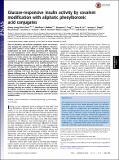| dc.contributor.author | Chou, Danny Hung-Chieh | |
| dc.contributor.author | Tang, Benjamin C. | |
| dc.contributor.author | Lin, Amy B. | |
| dc.contributor.author | Thapa, Lavanya S. | |
| dc.contributor.author | Deng, David | |
| dc.contributor.author | Truong, Jonathan V. | |
| dc.contributor.author | Webber, Matthew | |
| dc.contributor.author | Cortinas, Abel Bryan | |
| dc.contributor.author | Anderson, Daniel Griffith | |
| dc.contributor.author | Langer, Robert S | |
| dc.date.accessioned | 2015-08-05T14:41:44Z | |
| dc.date.available | 2015-08-05T14:41:44Z | |
| dc.date.issued | 2015-02 | |
| dc.date.submitted | 2014-12 | |
| dc.identifier.issn | 0027-8424 | |
| dc.identifier.issn | 1091-6490 | |
| dc.identifier.uri | http://hdl.handle.net/1721.1/98027 | |
| dc.description.abstract | Since its discovery and isolation, exogenous insulin has dramatically changed the outlook for patients with diabetes. However, even when patients strictly follow an insulin regimen, serious complications can result as patients experience both hyperglycemic and hypoglycemic states. Several chemically or genetically modified insulins have been developed that tune the pharmacokinetics of insulin activity for personalized therapy. Here, we demonstrate a strategy for the chemical modification of insulin intended to promote both long-lasting and glucose-responsive activity through the incorporation of an aliphatic domain to facilitate hydrophobic interactions, as well as a phenylboronic acid for glucose sensing. These synthetic insulin derivatives enable rapid reversal of blood glucose in a diabetic mouse model following glucose challenge, with some derivatives responding to repeated glucose challenges over a 13-h period. The best-performing insulin derivative provides glucose control that is superior to native insulin, with responsiveness to glucose challenge improved over a clinically used long-acting insulin derivative. Moreover, continuous glucose monitoring reveals responsiveness matching that of a healthy pancreas. This synthetic approach to insulin modification could afford both long-term and glucose-mediated insulin activity, thereby reducing the number of administrations and improving the fidelity of glycemic control for insulin therapy. The described work is to our knowledge the first demonstration of a glucose-binding modified insulin molecule with glucose-responsive activity verified in vivo. | en_US |
| dc.description.sponsorship | Leona M. and Harry B. Helmsley Charitable Trust (Award 2014PG-T1D002) | en_US |
| dc.description.sponsorship | Tayebati Family Foundation | en_US |
| dc.description.sponsorship | National Institutes of Health (U.S.) (Ruth L. Kirschstein National Research Service Award F32DK101335) | en_US |
| dc.description.sponsorship | Juvenile Diabetes Research Foundation International (Postdoctoral Fellowship 3-2011-310) | en_US |
| dc.description.sponsorship | Juvenile Diabetes Research Foundation International (Postdoctoral Fellowship 3-2013-56) | en_US |
| dc.language.iso | en_US | |
| dc.publisher | National Academy of Sciences (U.S.) | en_US |
| dc.relation.isversionof | http://dx.doi.org/10.1073/pnas.1424684112 | en_US |
| dc.rights | Article is made available in accordance with the publisher's policy and may be subject to US copyright law. Please refer to the publisher's site for terms of use. | en_US |
| dc.source | National Academy of Sciences (U.S.) | en_US |
| dc.title | Glucose-responsive insulin activity by covalent modification with aliphatic phenylboronic acid conjugates | en_US |
| dc.type | Article | en_US |
| dc.identifier.citation | Chou, Danny Hung-Chieh, Matthew J. Webber, Benjamin C. Tang, Amy B. Lin, Lavanya S. Thapa, David Deng, Jonathan V. Truong, Abel B. Cortinas, Robert Langer, and Daniel G. Anderson. “Glucose-Responsive Insulin Activity by Covalent Modification with Aliphatic Phenylboronic Acid Conjugates.” Proc Natl Acad Sci USA 112, no. 8 (February 9, 2015): 2401–2406. | en_US |
| dc.contributor.department | Massachusetts Institute of Technology. Institute for Medical Engineering & Science | en_US |
| dc.contributor.department | Harvard University--MIT Division of Health Sciences and Technology | en_US |
| dc.contributor.department | Massachusetts Institute of Technology. Department of Chemical Engineering | en_US |
| dc.contributor.department | Koch Institute for Integrative Cancer Research at MIT | en_US |
| dc.contributor.mitauthor | Chou, Danny Hung-Chieh | en_US |
| dc.contributor.mitauthor | Webber, Matthew | en_US |
| dc.contributor.mitauthor | Tang, Benjamin C. | en_US |
| dc.contributor.mitauthor | Lin, Amy B. | en_US |
| dc.contributor.mitauthor | Thapa, Lavanya S. | en_US |
| dc.contributor.mitauthor | Deng, David | en_US |
| dc.contributor.mitauthor | Truong, Jonathan V. | en_US |
| dc.contributor.mitauthor | Cortinas, Abel Bryan | en_US |
| dc.contributor.mitauthor | Langer, Robert | en_US |
| dc.contributor.mitauthor | Anderson, Daniel Griffith | en_US |
| dc.relation.journal | Proceedings of the National Academy of Sciences | en_US |
| dc.eprint.version | Final published version | en_US |
| dc.type.uri | http://purl.org/eprint/type/JournalArticle | en_US |
| eprint.status | http://purl.org/eprint/status/PeerReviewed | en_US |
| dspace.orderedauthors | Chou, Danny Hung-Chieh; Webber, Matthew J.; Tang, Benjamin C.; Lin, Amy B.; Thapa, Lavanya S.; Deng, David; Truong, Jonathan V.; Cortinas, Abel B.; Langer, Robert; Anderson, Daniel G. | en_US |
| dc.identifier.orcid | https://orcid.org/0000-0001-5629-4798 | |
| dc.identifier.orcid | https://orcid.org/0000-0002-8227-953X | |
| dc.identifier.orcid | https://orcid.org/0000-0003-1292-7180 | |
| dc.identifier.orcid | https://orcid.org/0000-0003-0624-3532 | |
| dc.identifier.orcid | https://orcid.org/0000-0003-4255-0492 | |
| mit.license | PUBLISHER_POLICY | en_US |
| mit.metadata.status | Complete | |
